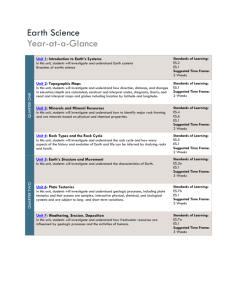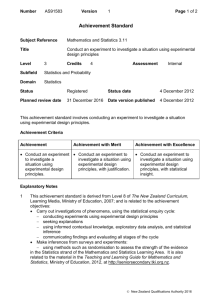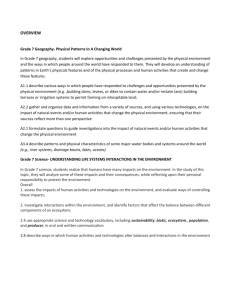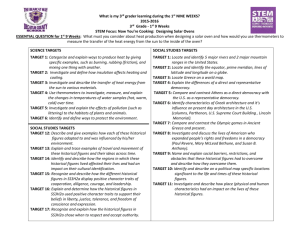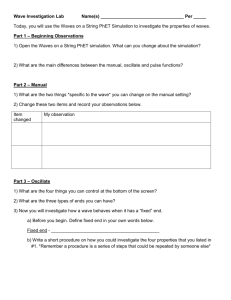WHAT YOUR CHILD WILL LEARN THIS YEAR IN PHYSICAL
advertisement
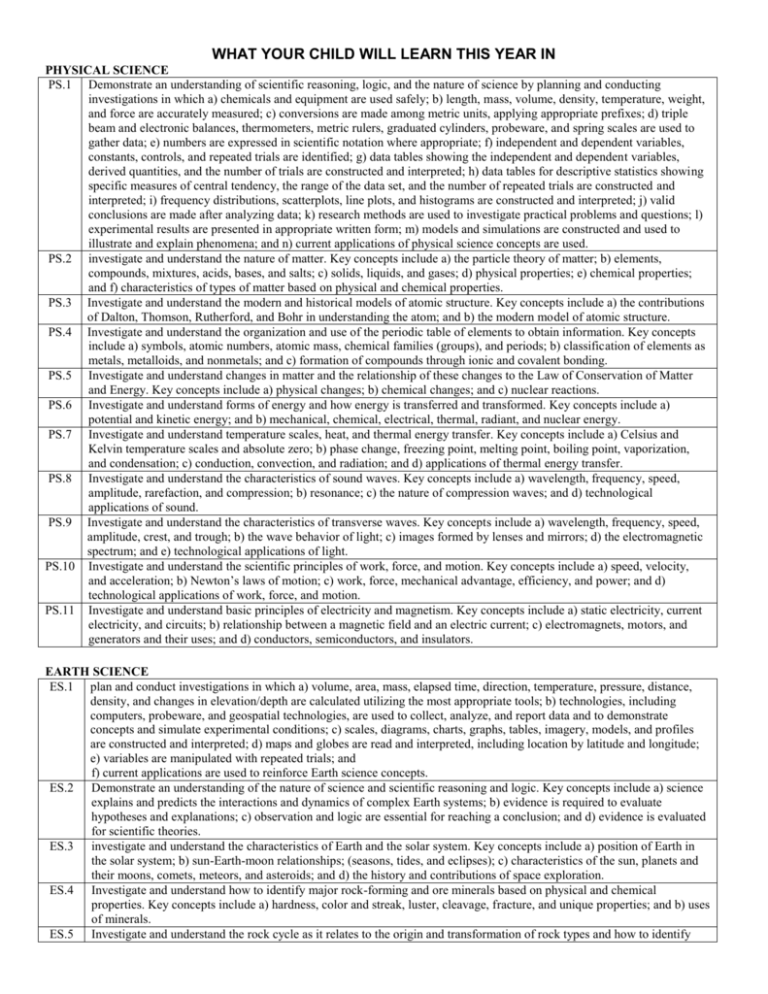
WHAT YOUR CHILD WILL LEARN THIS YEAR IN PHYSICAL SCIENCE PS.1 Demonstrate an understanding of scientific reasoning, logic, and the nature of science by planning and conducting investigations in which a) chemicals and equipment are used safely; b) length, mass, volume, density, temperature, weight, and force are accurately measured; c) conversions are made among metric units, applying appropriate prefixes; d) triple beam and electronic balances, thermometers, metric rulers, graduated cylinders, probeware, and spring scales are used to gather data; e) numbers are expressed in scientific notation where appropriate; f) independent and dependent variables, constants, controls, and repeated trials are identified; g) data tables showing the independent and dependent variables, derived quantities, and the number of trials are constructed and interpreted; h) data tables for descriptive statistics showing specific measures of central tendency, the range of the data set, and the number of repeated trials are constructed and interpreted; i) frequency distributions, scatterplots, line plots, and histograms are constructed and interpreted; j) valid conclusions are made after analyzing data; k) research methods are used to investigate practical problems and questions; l) experimental results are presented in appropriate written form; m) models and simulations are constructed and used to illustrate and explain phenomena; and n) current applications of physical science concepts are used. PS.2 investigate and understand the nature of matter. Key concepts include a) the particle theory of matter; b) elements, compounds, mixtures, acids, bases, and salts; c) solids, liquids, and gases; d) physical properties; e) chemical properties; and f) characteristics of types of matter based on physical and chemical properties. PS.3 Investigate and understand the modern and historical models of atomic structure. Key concepts include a) the contributions of Dalton, Thomson, Rutherford, and Bohr in understanding the atom; and b) the modern model of atomic structure. PS.4 Investigate and understand the organization and use of the periodic table of elements to obtain information. Key concepts include a) symbols, atomic numbers, atomic mass, chemical families (groups), and periods; b) classification of elements as metals, metalloids, and nonmetals; and c) formation of compounds through ionic and covalent bonding. PS.5 Investigate and understand changes in matter and the relationship of these changes to the Law of Conservation of Matter and Energy. Key concepts include a) physical changes; b) chemical changes; and c) nuclear reactions. PS.6 Investigate and understand forms of energy and how energy is transferred and transformed. Key concepts include a) potential and kinetic energy; and b) mechanical, chemical, electrical, thermal, radiant, and nuclear energy. PS.7 Investigate and understand temperature scales, heat, and thermal energy transfer. Key concepts include a) Celsius and Kelvin temperature scales and absolute zero; b) phase change, freezing point, melting point, boiling point, vaporization, and condensation; c) conduction, convection, and radiation; and d) applications of thermal energy transfer. PS.8 Investigate and understand the characteristics of sound waves. Key concepts include a) wavelength, frequency, speed, amplitude, rarefaction, and compression; b) resonance; c) the nature of compression waves; and d) technological applications of sound. PS.9 Investigate and understand the characteristics of transverse waves. Key concepts include a) wavelength, frequency, speed, amplitude, crest, and trough; b) the wave behavior of light; c) images formed by lenses and mirrors; d) the electromagnetic spectrum; and e) technological applications of light. PS.10 Investigate and understand the scientific principles of work, force, and motion. Key concepts include a) speed, velocity, and acceleration; b) Newton’s laws of motion; c) work, force, mechanical advantage, efficiency, and power; and d) technological applications of work, force, and motion. PS.11 Investigate and understand basic principles of electricity and magnetism. Key concepts include a) static electricity, current electricity, and circuits; b) relationship between a magnetic field and an electric current; c) electromagnets, motors, and generators and their uses; and d) conductors, semiconductors, and insulators. EARTH SCIENCE ES.1 plan and conduct investigations in which a) volume, area, mass, elapsed time, direction, temperature, pressure, distance, density, and changes in elevation/depth are calculated utilizing the most appropriate tools; b) technologies, including computers, probeware, and geospatial technologies, are used to collect, analyze, and report data and to demonstrate concepts and simulate experimental conditions; c) scales, diagrams, charts, graphs, tables, imagery, models, and profiles are constructed and interpreted; d) maps and globes are read and interpreted, including location by latitude and longitude; e) variables are manipulated with repeated trials; and f) current applications are used to reinforce Earth science concepts. ES.2 Demonstrate an understanding of the nature of science and scientific reasoning and logic. Key concepts include a) science explains and predicts the interactions and dynamics of complex Earth systems; b) evidence is required to evaluate hypotheses and explanations; c) observation and logic are essential for reaching a conclusion; and d) evidence is evaluated for scientific theories. ES.3 investigate and understand the characteristics of Earth and the solar system. Key concepts include a) position of Earth in the solar system; b) sun-Earth-moon relationships; (seasons, tides, and eclipses); c) characteristics of the sun, planets and their moons, comets, meteors, and asteroids; and d) the history and contributions of space exploration. ES.4 Investigate and understand how to identify major rock-forming and ore minerals based on physical and chemical properties. Key concepts include a) hardness, color and streak, luster, cleavage, fracture, and unique properties; and b) uses of minerals. ES.5 Investigate and understand the rock cycle as it relates to the origin and transformation of rock types and how to identify ES.6 ES.7 ES.8 ES.9 ES.10 ES.11 ES.12 ES.13 common rock types based on mineral composition and textures. Key concepts include a) igneous rocks; b) sedimentary rocks; and c) metamorphic rocks. Investigate and understand the differences between renewable and nonrenewable resources. Key concepts include a) fossil fuels, minerals, rocks, water, and vegetation; b) advantages and disadvantages of various energy sources; c) resources found in Virginia; and d) environmental costs and benefits. Investigate and understand geologic processes including plate tectonics. Key concepts include a) geologic processes and their resulting features; and b) tectonic processes. Investigate and understand how freshwater resources are influenced by geologic processes and the activities of humans. Key concepts include a) processes of soil development; b) development of karst topography; c) relationships between groundwater zones, including saturated and unsaturated zones, and the water table; d) identification of sources of fresh water including rivers, springs, and aquifers, with reference to the hydrologic cycle; e) dependence on freshwater resources and the effects of human usage on water quality; and f) identification of the major watershed systems in Virginia, including the Chesapeake Bay and its tributaries. Investigate and understand that many aspects of the history and evolution of Earth and life can be inferred by studying rocks and fossils. Key concepts include a) traces and remains of ancient, often extinct, life are preserved by various means in many sedimentary rocks; b) superposition, cross-cutting relationships, index fossils, and radioactive decay are methods of dating bodies of rock; c) absolute and relative dating have different applications but can be used together to determine the age of rocks and structures; and d) rocks and fossils from many different geologic periods and epochs are found in Virginia. Investigate and understand that oceans are complex, interactive physical, chemical, and biological systems and are subject to long- and short-term variations. Key concepts include a) physical and chemical changes related to tides, waves, currents, sea level and ice cap variations, upwelling, and salinity variations; b) importance of environmental and geologic implications; c) systems interactions; d) features of the sea floor as reflections of tectonic processes; and e) economic and public policy issues concerning the oceans and the coastal zone including the Chesapeake Bay. Investigate and understand the origin and evolution of the atmosphere and the interrelationship of geologic processes, biologic processes, and human activities on its composition and dynamics. Key concepts include a) scientific evidence for atmospheric composition changes over geologic time; b) current theories related to the effects of early life on the chemical makeup of the atmosphere; c) atmospheric regulation mechanisms including the effects of density differences and energy transfer; and d) potential changes to the atmosphere and climate due to human, biologic, and geologic activity. Investigate and understand that energy transfer between the sun and Earth and its atmosphere drives weather and climate on Earth. Key concepts include a) observation and collection of weather data; b) prediction of weather patterns; c) severe weather occurrences, such as tornadoes, hurricanes, and major storms; and d) weather phenomena and the factors that affect climate including radiation, conduction, and convection. Investigate and understand scientific concepts related to the origin and evolution of the universe. Key concepts include a) cosmology including the Big Bang theory; and b) the origin and evolution of stars, star systems, and galaxies. BIOLOGY BIO.1 Demonstrate an understanding of scientific reasoning, logic, and the nature of science by planning and conducting investigations in which a) observations of living organisms are recorded in the lab and in the field; b) hypotheses are formulated based on direct observations and information from scientific literature; c) variables are defined and investigations are designed to test hypotheses; d) graphing and arithmetic calculations are used as tools in data analysis; e) conclusions are formed based on recorded quantitative and qualitative data; f) sources of error inherent in experimental design are identified and discussed; g) validity of data is determined; h) chemicals and equipment are used in a safe manner; i) appropriate technology including computers, graphing calculators, and probeware, is used for gathering and analyzing data, communicating results, modeling concepts, and simulating experimental conditions; j) research utilizes scientific literature; k) differentiation is made between a scientific hypothesis, theory, and law; l) alternative scientific explanations and models are recognized and analyzed; and m) current applications of biological concepts are used. BIO.2 Investigate and understand the chemical and biochemical principles essential for life. Key concepts include a) water chemistry and its impact on life processes; b) the structure and function of macromolecules; c) the nature of enzymes; and d) the capture, storage, transformation, and flow of energy through the processes of photosynthesis and respiration. BIO.3 Investigate and understand relationships between cell structure and function. Key concepts include a) evidence supporting the cell theory; b) characteristics of prokaryotic and eukaryotic cells; c) similarities between the activities of the organelles in a single cell and a whole organism; d) the cell membrane model; and e) the impact of surface area to volume ratio on cell division, material transport, and other life processes. BIO.4 Investigate and understand life functions of Archaea, Bacteria and Eukarya. Key concepts include a) comparison of their metabolic activities; b) maintenance of homeostasis; c) how the structures and functions vary among and within the Eukarya kingdoms of protists, fungi, plants, and animals, including humans; d) human health issues, human anatomy, and body systems; e) how viruses compare with organisms; and f) evidence supporting the germ theory of infectious disease. BIO.5 Investigate and understand common mechanisms of inheritance and protein synthesis. Key concepts include a) cell growth and division; b) gamete formation; c) cell specialization; d) prediction of inheritance of traits based on the BIO.6 BIO.7 BIO.8 Mendelian laws of heredity; e) historical development of the structural model of DNA; f) genetic variation; g) the structure, function, and replication of nucleic acids; h) events involved in the construction of proteins; i) use, limitations, and misuse of genetic information; and j) exploration of the impact of DNA technologies. Investigate and understand bases for modern classification systems. Key concepts include a) structural similarities among organisms; b) fossil record interpretation; c) comparison of developmental stages in different organisms; d) examination of biochemical similarities and differences among organisms; and e) systems of classification that are adaptable to new scientific discoveries. Investigate and understand how populations change through time. Key concepts include a) evidence found in fossil records; b) how genetic variation, reproductive strategies, and environmental pressures impact the survival of populations; c) how natural selection leads to adaptations; d) emergence of new species; and e) scientific evidence and explanations for biological evolution. Investigate and understand dynamic equilibria within populations, communities, and ecosystems. Key concepts include a) interactions within and among populations including carrying capacities, limiting factors, and growth curves; b) nutrient cycling with energy flow through ecosystems; c) succession patterns in ecosystems; d) the effects of natural events and human activities on ecosystems; and e) analysis of the flora, fauna, and microorganisms of Virginia ecosystems. CHEMISTRY CH.1 Investigate and understand that experiments in which variables are measured, analyzed, and evaluated produce observations and verifiable data. Key concepts include a) designated laboratory techniques; b) safe use of chemicals and equipment; c) proper response to emergency situations; d) manipulation of multiple variables, using repeated trials; e) accurate recording, organization, and analysis of data through repeated trials; f) mathematical and procedural error analysis; g) mathematical manipulations including SI units, scientific notation, linear equations, graphing, ratio and proportion, significant digits, and dimensional analysis; h) use of appropriate technology including computers, graphing calculators, and probeware, for gathering data, communicating results, and using simulations to model concepts; i) construction and defense of a scientific viewpoint; and j) the use of current applications to reinforce chemistry concepts. CH.2 Investigate and understand that the placement of elements on the periodic table is a function of their atomic structure. The periodic table is a tool used for the investigations of a) average atomic mass, mass number, and atomic number; b) isotopes, half lives, and radioactive decay; c) mass and charge characteristics of subatomic particles; d) families or groups; e) periods; f) trends including atomic radii, electronegativity, shielding effect, and ionization energy; g) electron configurations, valence electrons, and oxidation numbers; h) chemical and physical properties; and i) historical and quantum models. CH.3 Investigate and understand how conservation of energy and matter is expressed in chemical formulas and balanced equations. Key concepts include a) nomenclature; b) balancing chemical equations; c) writing chemical formulas; d) bonding types; e) reaction types; and f) reaction rates, kinetics, and equilibrium. CH.4 Investigate and understand that chemical quantities are based on molar relationships. Key concepts include a) Avogadro’s principle and molar volume; b) stoichiometric relationships; c) solution concentrations; and d) acid/base theory; strong electrolytes, weak electrolytes, and nonelectrolytes; dissociation and ionization; pH and pOH; and the titration process. CH.5 Investigate and understand that the phases of matter are explained by kinetic theory and forces of attraction between particles. Key concepts include a) pressure, temperature, and volume; b) partial pressure and gas laws; c) vapor pressure; d) phase changes; e) molar heats of fusion and vaporization; f) specific heat capacity; and g) colligative properties. CH.6 Investigate and understand how basic chemical properties relate to organic chemistry and biochemistry. Key concepts include a) unique properties of carbon that allow multi-carbon compounds; and b) uses in pharmaceuticals and genetics, petrochemicals, plastics, and food. PHYSICS PH.1 Plan and conduct investigations using experimental design and product design processes. Key concepts include a) the components of a system are defined; b) instruments are selected and used to extend observations and measurements; c) information is recorded and presented in an organized format; d) the limitations of the experimental apparatus and design are recognized; e) the limitations of measured quantities are recognized through the appropriate use of significant figures or error ranges; f) models and simulations are used to visualize and explain phenomena, to make predictions from hypotheses, and to interpret data; and g) appropriate technology, including computers, graphing calculators, and probeware, is used for gathering and analyzing data and communicating results. PH.2 Investigate and understand how to analyze and interpret data. Key concepts include a) a description of a physical problem is translated into a mathematical statement in order to find a solution; b) relationships between physical quantities are determined using the shape of a curve passing through experimentally obtained data; c) the slope of a linear relationship is calculated and includes appropriate units; d) interpolated, extrapolated, and analyzed trends are used to make predictions; and e) situations with vector quantities are analyzed utilizing trigonometric or graphical methods. PH.3 Investigate and demonstrate an understanding of the nature of science, scientific reasoning, and logic. Key concepts include a) analysis of scientific sources to develop and refine research hypotheses; b) analysis of how science explains and predicts relationships; c) evaluation of evidence for scientific theories; d) examination of how new discoveries result PH.4 PH.5 PH.6 PH.7 PH.8 PH.9 PH.10 PH.11 PH.12 in modification of existing theories or establishment of new paradigms; and e) construction and defense of a scientific viewpoint. Investigate and understand how applications of physics affect the world. Key concepts include a) examples from the real world; and b) exploration of the roles and contributions of science and technology. Investigate and understand the interrelationships among mass, distance, force, and time through mathematical and experimental processes. Key concepts include a) linear motion; b) uniform circular motion; c) projectile motion; d) Newton’s laws of motion; e) gravitation; f) planetary motion; and g) work, power, and energy. Investigate and understand that quantities including mass, energy, momentum, and charge are conserved. Key concepts include a) kinetic and potential energy; b) elastic and inelastic collisions; and c) mass/energy equivalence. Investigate and understand that energy can be transferred and transformed to provide usable work. Key concepts include a) transfer and storage of energy among systems including mechanical, thermal, gravitational, electromagnetic, chemical, and nuclear systems; and b) efficiency of systems. Investigate and understand wave phenomena. Key concepts include a) wave characteristics; b) fundamental wave processes; and c) light and sound in terms of wave models. Investigate and understand that different frequencies and wavelengths in the electromagnetic spectrum are phenomena ranging from radio waves through visible light to gamma radiation. Key concepts include a) the properties, behaviors, and relative size of radio waves, microwaves, infrared, visible light, ultraviolet, X-rays, and gamma rays; b) wave/particle dual nature of light; and c) current applications based on the respective wavelengths. Investigate and understand how to use the field concept to describe the effects of gravitational, electric, and magnetic forces. Key concepts include a) inverse square laws (Newton’s law of universal gravitation and Coulomb’s law); and b) technological applications. Investigate and understand how to diagram, construct, and analyze basic electrical circuits and explain the function of various circuit components. Key concepts include a) Ohm’s law; b) series, parallel, and combined circuits; c) electrical power; and d) alternating and direct currents. Investigate and understand that extremely large and extremely small quantities are not necessarily described by the same laws as those studied in Newtonian physics. Key concepts may include a) wave/particle duality; b) wave properties of matter; c) matter/energy equivalence; d) quantum mechanics and uncertainty; e) relativity; f) nuclear physics; g) solid state physics; h) nanotechnology; i) superconductivity; and j) radioactivity.



